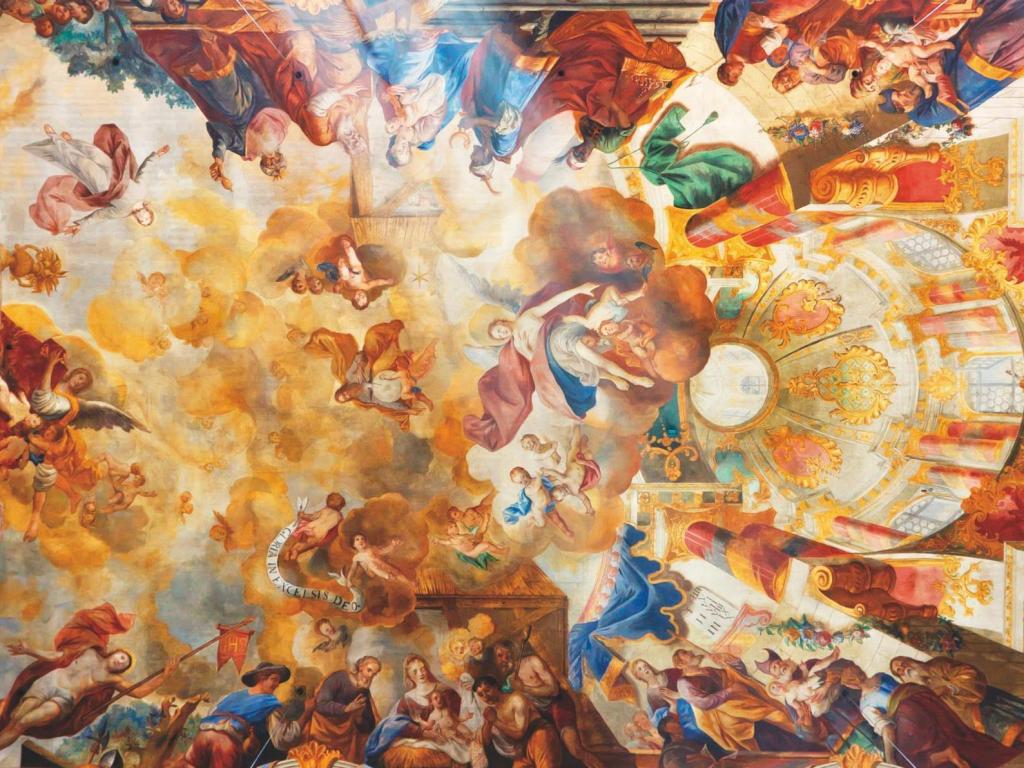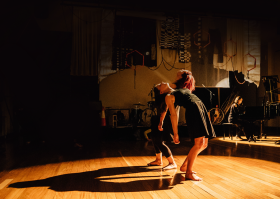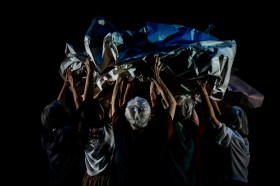Image: Biberach Ceiling St. Martin’s Church courtesy Australian Chamber Choir.
Late on a golden winter afternoon in Melbourne the Australian Chamber Choir performed the second concert in its 2016 Series in the Church of Our Lady of Mount Carmel, Middle Park to a capacity audience. The concert took its name from the title of a recent publication by British musician John Eliot Gardiner, and interspersed three of Bach’s six Motets (core repertoire for this ensemble) with music by Bach’s father-in-law, Johann Michael Bach; Herbert Howells; Gregorio Allegri and Olivier Messiaen.
The choir of 18 voices was formed in 2007 by the veteran choral director and organist Douglas Lawrence. It regularly tours Europe, often including new Australian work alongside established repertoire. Based on the standard collegiate choir model, each of the 18 members demonstrates musical training. Its marketing is fresh and attractive; a Tenth Anniversary tour of Europe is planned next year. On this occasion, blend between sopranos and the rest of the choir could have been worked on more, the sound quality and pitch of the altos needed improvement, but the blend between tenors and basses was good, and the four basses represented the best section in the choir.
Johann Michael Bach’s Das Blut Jesu Christi is a short, five-part, Lutheran motet usually accompanied by brass instruments with basso continuo though here sung with chamber organ and cello (both instrumentalist were also singers in the choir). It presented few challenges for the ensemble and provided a logical, contextual opening to the concert.
J S Bach’s six Motets are wonderful creations. Having passed its zenith by the beginning of the 18th Century, the form has presented an interesting performance practice history over recent decades. The motets may be performed with doubling instruments and/or continuo or not, at a wide variety of speeds and in different combinations of voices from one per part to larger forces or combinations of the two. On this occasion Lobet den Herrn, alle Heiden was again accompanied by chamber organ and cello. A sprightly speed was instigated which promised and delivered a lightness of touch with some soprano sharpness surfacing at the end.
The two extant of the Four Motets for the Blessed Virgin Mary (Salve Regina and Regina caeli) by Herbert Howells followed and a separate, posthumously published setting for unaccompanied voices of the Nunc dimittis. All three works were composed for the choir of Westminster Cathedral in London. Throughout his life Howells took inspiration from and account of the architecture of the buildings for which he wrote, so the vast interior of the newly completed Westminster Cathedral is here aptly matched in scale by the two Marian motets, with immense phrases needing to be carried and vast sound clouds designed to be built up within this cavernous cathedral space. These works were conceived for a very different ensemble and space than this; something of a relay team of distant singers is required in a highly resonant acoustic. Some way through I felt the Australian Chamber Choir, trying its best to negotiate these demands, understandably ran out of puff.
Matters further declined with the programming of the longest and most strenuous of Bach’s motets, Jesu meine Freude, BWV 227 following this. Tuning soon began to suffer, tone became thin, energy waned and rhetoric of text dulled; the long Gute Nacht, O Wesen section seemed uniquely apt.
Gregorio Allegri’s Miserere, a setting of the penitential Psalm 51, has appeared with some regularity in choral concerts for decades. Newer editions have made the work more interesting, though on this occasion an earlier standard edition was used. Doubtless to boost sales, anglicised editions such as this shaped the work as suitable music for a typical British church choir dividing the work into a regular four beats in the bar and using customary voices; most importantly, these versions avoid the fact that solo embellimenti sections were improvised by the highly skilled, Baroque soloists within the Sistine Chapel choir of which Allegri was one. Singing these elaborate and virtuosic passages over and over with the same written-out material is not what was intended, though tenor soloist Jacob Lawrence did his best to at least provide some variation towards the end. The chant sections sung by tenors and basses sounded fine and blended though the Latin could have been more secure. A false start to the final section disappointed. Throughout, the attractive voice of solo soprano Erika Tandiono delighted for its warm musicality and precision singing one high ‘C’ after another.
Olivier Messiaen’s striking, four-part sacramental motet, O sacrum convivium! from 1937 is one of the composer’s purest works in that the technical musical language used and refined aesthetic encapsulates everything the composer was later to achieve on a much larger scale. It evokes a sense of timelessness through irregular and very slow pulse, and it finishes on what Messiaen considered ‘the perfect chord’. It is written mostly in the composer’s favourite mode treasured for its heightened sense of tonal ambiguity, a tonality which can be either supported or left hovering and unsettled. This makes the work notoriously difficult to sing in tune by voices alone. Choirs would have more success if they were to understand and savour the characteristics of the mode rather than attempting to negotiate a series of difficult chords by pitching individual notes. The alto section suffered particularly insecure tuning throughout.
Another of the Bach motets and perhaps the most popular, J S Bach’s Singet dem Herren ein neues Lied, BWV 225 for two choirs finished the concert and was performed a cappella. Again, a lively pace was chosen and it soon became evident that this work was securely known. The quartet sections had Jacob Lawrence again embellishing sections and I wondered why his interesting ornamentation was not followed by the other parts; the blend of solo bass (Steve Hodgson) and tenor here sounded particularly fine.
Rating: 3.5 stars out of 5
Bach in the Castle of Heaven – The Australian Chamber Choir
Douglas Lawrence, director
Presented by The Australian Chamber Choir
Our Lady of Mount Carmel, Middle Park
Sunday 12 June 2016
This program will also be performed on the following dates and venues:
St Jude’s Anglican Church, Bowral
Saturday, 20 August, 2016
3pm
St Mary’s Cathedral, Sydney
Sunday, 21 August, 2016
2.30pm
The Church of the Resurrection, Macedon
Saturday, 27 August
3pm
St Mary of the Angels Basilica, Geelong
Sunday, 28 August, 2016
3pm





